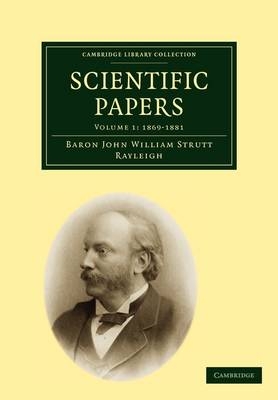
Scientific Papers
Seiten
2009
Cambridge University Press (Verlag)
978-1-108-00542-5 (ISBN)
Cambridge University Press (Verlag)
978-1-108-00542-5 (ISBN)
Nobel laureate Lord Rayleigh was justifiably renowned for the clarity and quality of his work, which has had a continuing impact on modern science. This first of six chronological volumes of his most important scientific papers covers the period 1869–1881, including the early work relating light scattering to wavelength.
Lord Rayleigh (1842–1919) won the Nobel Prize for physics in 1904. His early research was in optics and acoustics but his first published paper, from 1869, was an explanation of Maxwell's electromagnetic theory. In 1871, he related the degree of light scattering to wavelength (part of the explanation for why the sky is blue), and in 1872 he wrote his classic Theory of Sound (not included here). He became a Fellow of the Royal Society and inherited his father's peerage in 1873. Rayleigh nevertheless continued groundbreaking research, including the first description of Moiré interference (1874). In 1881, while president of the London Mathematical Society (1878–1880) and successor to Maxwell as Cavendish Professor of Experimental Physics at Cambridge (1879–1884), Rayleigh published a paper on diffraction gratings which led to improvements in the spectroscope and future developments in high-resolution spectroscopy. This volume contains papers from 1869 to 1881.
Lord Rayleigh (1842–1919) won the Nobel Prize for physics in 1904. His early research was in optics and acoustics but his first published paper, from 1869, was an explanation of Maxwell's electromagnetic theory. In 1871, he related the degree of light scattering to wavelength (part of the explanation for why the sky is blue), and in 1872 he wrote his classic Theory of Sound (not included here). He became a Fellow of the Royal Society and inherited his father's peerage in 1873. Rayleigh nevertheless continued groundbreaking research, including the first description of Moiré interference (1874). In 1881, while president of the London Mathematical Society (1878–1880) and successor to Maxwell as Cavendish Professor of Experimental Physics at Cambridge (1879–1884), Rayleigh published a paper on diffraction gratings which led to improvements in the spectroscope and future developments in high-resolution spectroscopy. This volume contains papers from 1869 to 1881.
Preface; Scientific papers 1–78.
| Erscheint lt. Verlag | 20.7.2009 |
|---|---|
| Reihe/Serie | Cambridge Library Collection - Mathematics ; Volume 1 |
| Zusatzinfo | Worked examples or Exercises |
| Verlagsort | Cambridge |
| Sprache | englisch |
| Maße | 170 x 244 mm |
| Gewicht | 920 g |
| Themenwelt | Naturwissenschaften ► Physik / Astronomie ► Atom- / Kern- / Molekularphysik |
| ISBN-10 | 1-108-00542-X / 110800542X |
| ISBN-13 | 978-1-108-00542-5 / 9781108005425 |
| Zustand | Neuware |
| Haben Sie eine Frage zum Produkt? |
Mehr entdecken
aus dem Bereich
aus dem Bereich
Buch | Softcover (2024)
Wiley-VCH (Verlag)
59,90 €


